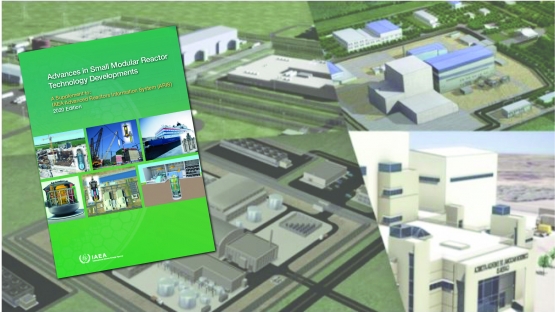A new IAEA publication on small modular reactors (SMRs), among the most promising emerging technologies in nuclear power, can help countries identify reactor designs to suit their needs as they look for reliable and affordable energy sources to slash greenhouse gas emissions and drive sustainable development.
The 2020 edition of the biennial IAEA booklet Advances in Small Modular Reactor Technology Developments, published last month, provides the latest data and information on SMRs around the world, including detailed descriptions of 72 reactors under development or construction in 18 countries. Expanding on the previous edition, the booklet for the first time contains annexes on waste management and disposal as well as a section on microreactors, which are very small SMRs intended for niche applications.
“SMRs’ unique attributes in terms of efficiency, flexibility and economics may position them to play a key role in the clean energy transition,” said Stefano Monti, Head of the IAEA’s Nuclear Power Technology Development Section and moderator of a recent webinar marking the release of the publication. “Countries can use the updated booklet as an additional tool for identifying possible technological solutions to the challenges they face on energy, climate change and sustainable development.”
Unlike large power reactors, SMRs typically clock in at up to 300 MW(e) and are built largely from prefabricated components assembled on site. They are designed for less upfront capital and have wider financing schemes. Their modular nature also allows for scaling up capacity by adding units according to demand. SMRs may also be well suited to operate flexibly in tandem with variable renewable energy sources such as wind and solar and for non-electric applications such as seawater desalination, district heating and hydrogen production.
While wider deployment of SMRs is expected to begin over the next decade, two reactor units of KLT-40S design are already in operation in Russia aboard the Akademik Lomonosov, a floating nuclear power plant (NPP). Two other SMR frontrunners in Argentina and China are due to begin operation within the next three years. Argentina, China and Russia presented their progress on SMR technology in the webinar.
The Akademik Lomonosov became the world’s first SMR power plant to enter commercial operation when it was connected to the grid in Russia’s remote Chukotka region in December 2019. It’s also the world’s northernmost NPP, providing both heat and electricity to the sparsely populated area and facilitating the shutdown of the coal-fired Chaunsk power plant.
Russia is also developing a land based SMR project planned for commissioning in 2027, according to Elena Pashina, Marketing Director for Rusatom Overseas. “SMR NPPs can provide electricity to remote areas and areas with grid restrictions at a favourable price as compared with alternatives and also satisfy growing energy needs,” she added.
Argentina is developing the CAREM SMR, with construction of the prototype nearing completion. The 25MW(e) CAREM utilizes natural circulation for cooling and includes passive safety features such as an automatic residual heat removal system. The CAREM, the first nuclear reactor designed entirely by Argentina, is intended for small electric grids and may also support seawater desalination.
“The CAREM25 prototype is the first step in the development of a competitive SMR, and it will facilitate licensing activities for the commercial modules and local supplier development,” said Dario Delmastro, Engineering Manager of the CAREM Project at the National Nuclear Energy Agency of Argentina. “CAREM will allow for nuclear power deployments in remote areas and small grids, providing a stable supply of electricity while reducing carbon emissions.”
China’s HTR-PM, a prototype high-temperature gas cooled SMR located in Shidao Bay, is slated to begin operation next year. The reactor is cooled by helium and capable of reaching temperatures as high as 750 degrees Celsius, making it suitable for non-electric applications such as district heating and hydrogen production. The HTR-PM is also designed with inherent safety features that reduce the risk of radioactive releases.
The Advances in SMR Technology Developments booklet series was first published in 2014. The publication serves as a supplement to the IAEA’s Advanced Reactors Information System (ARIS), an online database with comprehensive information on the latest developments in advanced reactors.






